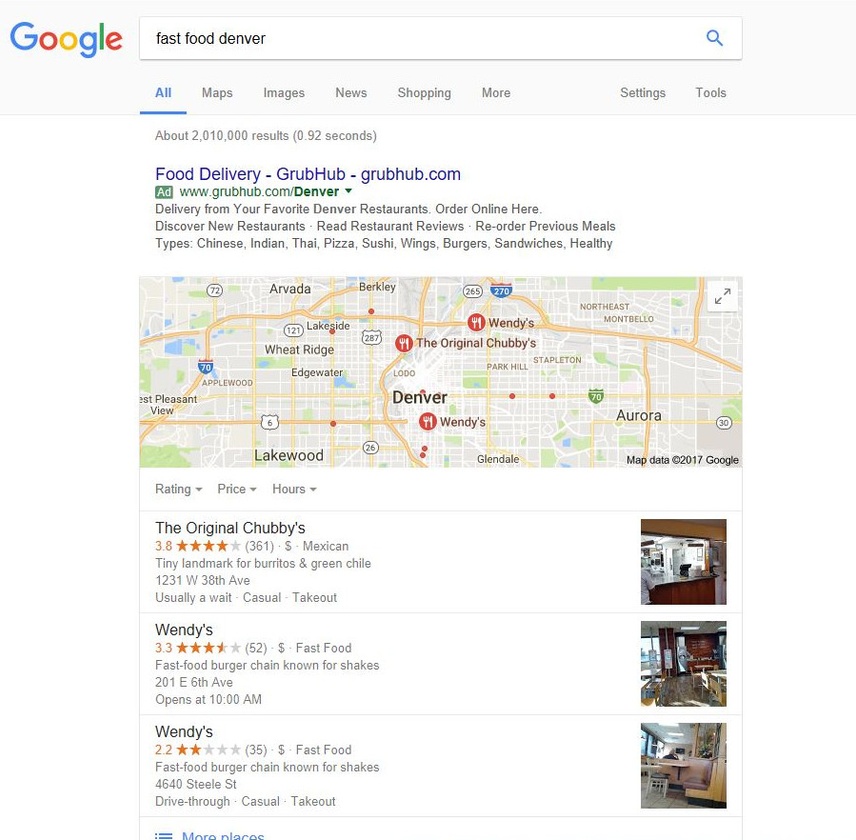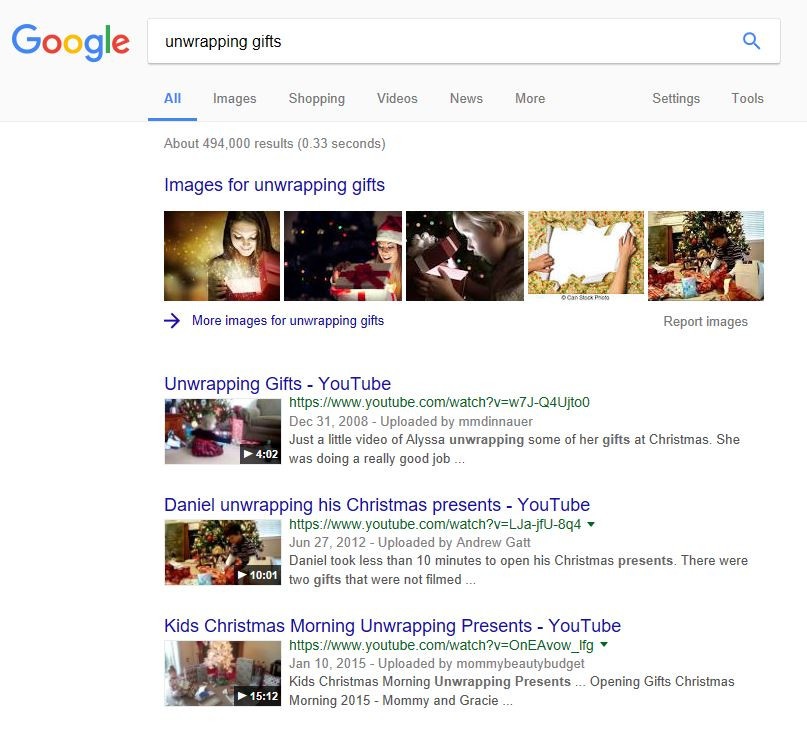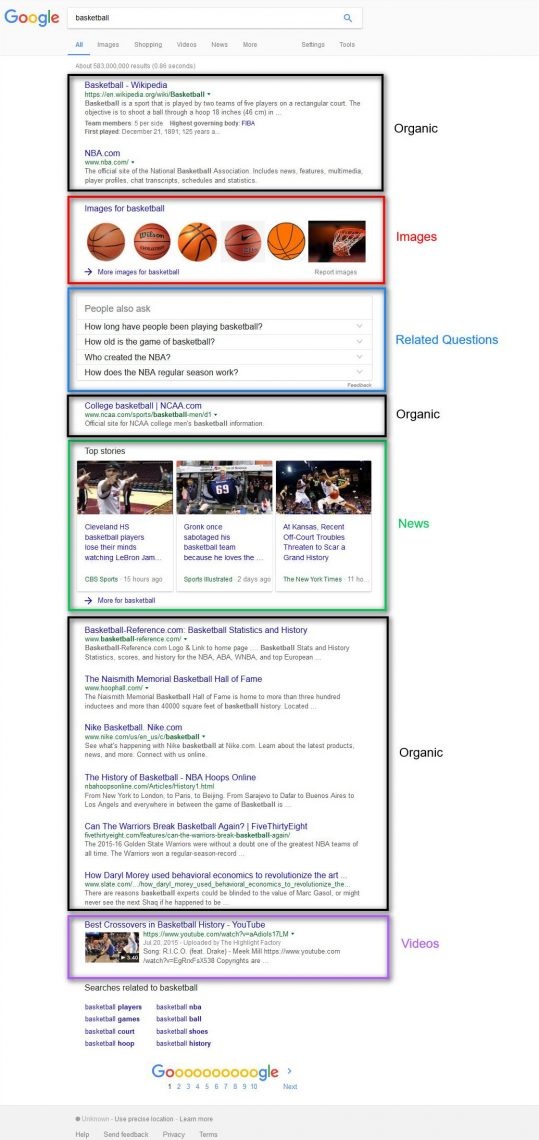Universal Search
In the context of search engine optimization, “Universal Search” (also called “Blended Search” or “Enhanced Search”) refers to the integration of additional media like videos, images or maps – displayed above or amongst the organic search results of search engines like Google or Bing.
Since April 2007, the search engine results list has been more than a listing of 10 blue links. Since then, Google has embedded boxes with additional media, which appear above, amongst, and/or alongside the actual organic search results. Depending on the user intent, these results have higher click rates as well as promising additional traffic.
This expansion including videos, images, maps, shopping results or news in the Google SERPs is commonly referred to as Universal Search Integration, sometimes also as “enhanced” or “blended” search. Now these elements, especially images, are also sometimes part of the Google Knowledge Graph, which frequently concerns maps and images.
Universal vs Extended Search
In comparison with the Universal Search which are based on vertical search engines, the Extended search boxes are based on an analysis of the organic results (e.g. for the Direct Answers), or on internal/external data sources (e.g. for the Knowledge graph). Google is continuously developing and implementing new types of Extended Search Integrations.
Why ‘Universal’?
The term ‘universal’ is used to refer to these displayed results because they provide content not just as a link to a URL – but in the precise form that is needed to meet the user intent, included additionally to the (former) ten blue links. That’s why Universal Search results are often referred to as “boxes”, because they (used to) appear with a frame separating them from other SERP elements.
Google’s aim is to make the types of content provided as universal as possible. Each update to this feature brings new possibilities, such as film listings, the current weather and social media or app integration, including specific results for mobile search. In this way, the range of content already visible on the SERP is getting closer and closer to becoming truly universal.
An overview of integration
New updates have seen various integrations of Universal Search, which in some cases greatly differ from one another. For our analyses, which we repeat on an annual basis, the following integrations are considered the most relevant, as these are applicable for the widest variety of search queries:
- Videos
- Images
- Maps
- Shopping/Product Listing Ads (PLA)
- News
Specifically, for mobile, the integration of app boxes, with direct access to the Google Play Store, is also of great importance. Furthermore, local listings for highly local search queries can be expected to become increasingly relevant.
Shopping/ now PLA
Initially launched as “Froogle” in 2002, the product price comparison was renamed Google Shopping in 2012. Since 2013, Google Shopping was renamed Product Listing Ad and is no longer free of charge. This is why PLA is not really considerable as a true part of Universal Search anymore. The PLAs are image-based advertisements paid by the provider for products searches that can be found above the search results. They contain the product names, price, product photos and a link to the provider.
Maps
A Maps Box – especially in mobile search results – is also widely integrated. This box is displayed by Google especially in combination with local search requests, as shown below.

Videos
In the case of videos, the boundary between organic search results and additional boxes is a fluid one. For example, videos are now listed as organic search results (not being separated by a frame or “box” anymore). Videos have therefore become a kind of “hybrid” between organic results and additional integrations.

The purpose of Universal Search
Google integrated the vertical search engines in the results of the organic search for relevant keyword searches in 2007. The term “Universal Search” covers results from areas such as News, Images, Maps, Video, and Shopping, now implemented in the organic search results and can be individually selected via the menu at the top of the search, which is not fixed but changes according the user’s query. Enriching the results pages of certain search queries with integrations is an extremely important factor in Google’s intention to always deliver the user ‘the best result’ for their individual search request in as short a time as possible.
Universal Search is intended to minimize the user’s effort and time to search for further results, eliminating the need for long tail queries. This means the integration of media in the SERPs allows Google to better determine user intentions. This increases the probability of instantly providing content which fulfils the users’ needs, while at the same time minimizing the search effort and number of search queries. In short – the user should find exactly what they’re looking for as quickly as possible.
Influencing factors
The number, position, and frequency of Universal Search integrations not only vary depending on the search queries (=keywords). They are also influenced by factors such as someone’s search history, their device (desktop, tablet or mobile), whether the user is logged into Google, whether their location can be localized using their IP, and whether any cookies have been saved. Generally speaking, Google gathers this information, as well as data from its Chrome browser, Android and myriad other sources to personalize results as much as possible.
Searchmetrics analyses
We at Searchmetrics have been doing analyses of Universal Search since 2013. Every year, we look at the most current developments and share our data and interpretations with you.
Database and data timeliness
Our Universal Search analyses are based on data from our software, which crawls search results for many millions of keywords. The database generally includes the first five search results pages – in several detailed analyses, only the foremost SERPs. For example, news is only shown on the first page.
Our data is compiled in a calendar year, from January to December, and its development is usually evaluated over the course of this period.
Absolute distribution vs. market share
The integration of Universal Search can principally be analyzed from two different angles – by its absolute distribution and by its occurrence according to keyword share.

1. Distribution by ‘market share’
What we call ‘market share’ of the individual integrations refers to the share of all inspected keywords for which the one “universal” integration – for example, videos – is displayed. Even though there are results without Universal Search integrations, the sum of all elements is over 100%. Often numerous integrations are shown for one keyword, with their added share then combining to total more than 100%.
For example, “basketball” returns organic results, news, images, videos, and related questions:
2. Frequency of individual integration elements
The second possibility for analyses is the absolute distribution and frequency of the elements. Numerous integrations are often delivered for one search result, particularly for images, shopping (PLAs) and news. Our calculation is based on the sum of all individual integrations of images, videos, etc. that, when added up, result in a total value of 100%. Accordingly, the shares of the elements of an integration type can be determined by the totality of all Universal Search integrations.
Furthermore, our analysis takes into account the absolute frequency of individual integration types in their percentage developments, in order to provide a more accurate illustration of the actual trends.
Analysis of individual integration types
The third section of our Universal Search studies is the detailed analysis of individual types of integrations. Here some – such as video – of the shares of individual market participants are analyzed. The analysis of news integrations also plays an important role. Here, the analysis is not limited to the number of elements played out per integration, but we also focus on the number of different domains that Google delivers for the news results.
The Diversity of Universal Search
As Google’s handling of search queries becomes ever more differentiated, there are now several hundred different kinds of Universal Search integrations. Here are 10 examples:
Where does ‘universal’ end?
Promoting good – or even the best possible content – has been Google’s aim for a long time. Introducing expansions and new integrations will continue to make the range of results ever-more universal. This is a great opportunity for Google to explore user behavior and to measure how different content meets user intent for different search queries. Looking forward, we can expect integrations, particularly on mobile, to become ever-more specific, meaning that SEOs and content strategists have to be aware of the latest developments, incorporating them into their work and taking advantage of the new possibilities for reaching out directly to users.


